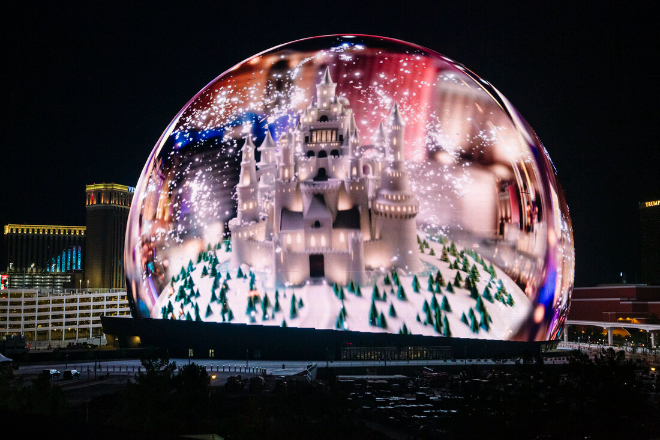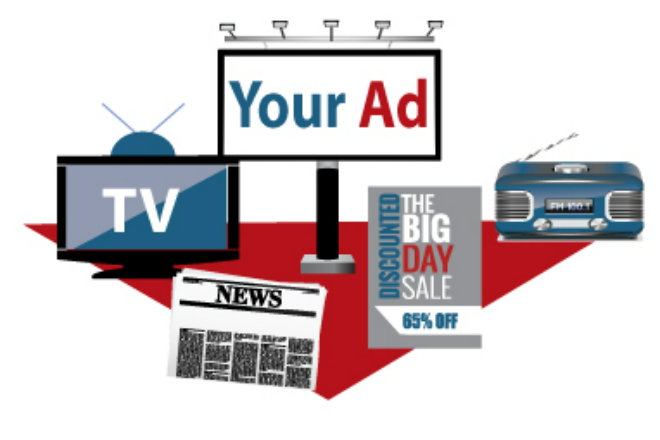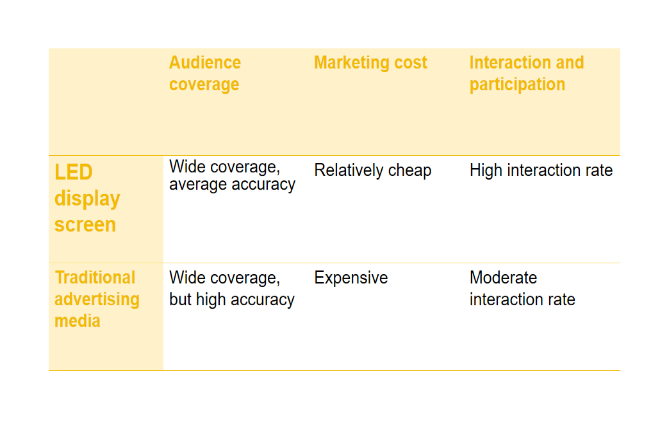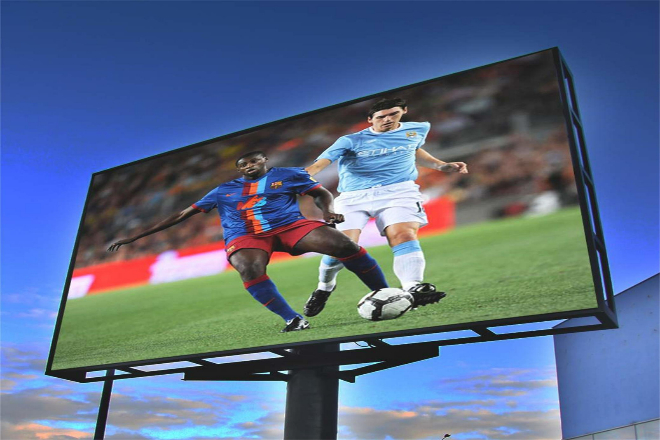Introduction

De la télévision traditionnelle, de la radio, des journaux et des magazines aux médias émergents Afficheurs LED, la publicité en ligne et les médias sociaux, la forme des supports publicitaires a évolué, offrant aux spécialistes du marketing des choix plus diversifiés.
Cependant, face à la multitude de supports publicitaires, choisir le canal marketing le plus adapté est devenu pour nous un problème difficile.
En particulier, l'affichage LED et les supports publicitaires traditionnels, deux formes de publicité dominantes sur le marché actuel, présentent chacun leurs avantages et leurs applications. Alors, lequel des deux offre le meilleur effet marketing : l'affichage LED ou les supports publicitaires traditionnels ?
1. Quel est l’effet marketing des écrans LED ?
 1). Caractéristiques techniques
1). Caractéristiques techniques
1.1). Avantages techniques
L'écran LED est une source de fierté pour la technologie moderne ! Sa haute luminosité est aussi éblouissant que le soleil, et les gens peuvent voir son contenu d'un seul coup d'œil, même dans la rue pendant les chaudes journées d'été. résolution c'est encore plus étonnant, et chaque détail est clairement visible, tout comme si l'on déplaçait l'écran de cinéma directement dans la vie réelle.
Il y a aussi la particularité des couleurs riches, qui est tout simplement le créateur de festins visuels, et diverses couleurs vives s'entrelacent, rendant les gens éblouis.
Dans certains cas, les avantages de l'affichage LED sont encore plus évidents. Par exemple, en extérieur, qu'il vente, qu'il pleuve ou qu'il fasse beau, il reste stable et transmet des informations précises à tous.
Il existe également des lieux d'événements à grande échelle, où l'écran LED est comme une immense scène, présentant des moments merveilleux un par un, permettant au public de s'y immerger et de s'y attarder.
1.2). Avantages de l'application dans des scénarios spécifiques
Imaginez que, dans un quartier commerçant animé, un immense écran LED diffuse les dernières publicités de mode. Sa luminosité et sa résolution sont tout simplement impossibles à ignorer.
C'est l'avantage des écrans LED en extérieur : ils résistent au vent, à la pluie et au soleil, et offrent un affichage optimal en permanence.
Dans les grands événements, les écrans LED jouent un rôle encore plus important. Qu'il s'agisse d'un concert, d'un match ou d'un lancement de produit, ils peuvent sublimer l'atmosphère. L'image géante et les effets sonores saisissants plongent le public dans un monde de rêve.
2). Effet de communication
2.1). L'impact des effets d'affichage dynamique sur l'attention du public
L'effet d'affichage dynamique des écrans LED est une arme magique pour capter l'attention du public ! Qu'il s'agisse d'animation, de vidéo ou de défilement de texte, ils captent l'attention du public à une vitesse fulgurante.
L'impact visuel est irrésistible. En marchant dans la rue, si vous voyez un écran LED diffusant des animations ou des vidéos intéressantes, vous vous arrêterez certainement pour y jeter un coup d'œil.
2.2). Immédiateté et flexibilité dans la diffusion de l'information
Les écrans LED offrent une diffusion d'informations à la fois instantanée et flexible. Qu'il s'agisse des dernières actualités ou des informations promotionnelles des commerçants, ils permettent pour la première fois de diffuser l'information au public.
De plus, le changement de contenu est extrêmement pratique. Grâce à des opérations simples, le contenu affiché à l'écran peut être actualisé. Cette rapidité et cette flexibilité font des écrans LED un outil puissant pour la promotion des commerçants.
2. Quel est l’effet marketing des médias publicitaires traditionnels ?

1). Type de support
En parlant de médias publicitaires traditionnels, il faut d'abord évoquer leurs principaux types, tels que la télévision, la radio, les journaux et les magazines. Ce sont de « vieux amis » que nous croisons souvent au quotidien.
- TV:
La publicité télévisée est un véritable régal pour les yeux et les oreilles ! Qu'il s'agisse d'une intrigue amusante ou d'effets spéciaux captivants, elle peut faire briller les yeux et dresser les oreilles. De plus, la publicité télévisée bénéficie d'une couverture très large. Presque tous les foyers possèdent un téléviseur ; son pouvoir de diffusion est donc considérable.
- Radio:
Les publicités radio sont des « artistes sonores » ! En voiture, en jogging le matin ou au lit le soir, allumez la radio et vous entendrez toutes sortes de publicités intéressantes. L'accès à la radio est illimité. Avec une radio, vous pouvez écouter des informations publicitaires du monde entier.
- Journal:
Les annonces dans les journaux sont un véritable terrain de jeu pour les mots ! Elles contiennent de nombreux mots, des informations complètes et des détails riches.
Pour les amateurs de lecture, les annonces dans les journaux sont un véritable plaisir. De plus, leur public est très large : des personnes âgées aux enfants, ils peuvent devenir lecteurs.
- Revues:
Les publicités dans les magazines sont un véritable festin visuel ! Elles présentent de magnifiques images et une multitude de designs, ce qui donne envie de les collectionner. De plus, les magazines s'adressent généralement à des publics spécifiques, comme les magazines de mode, les magazines automobiles, etc., ce qui rend leurs publicités plus pertinentes.
Parlons des caractéristiques d'audience et de la couverture de ces médias publicitaires traditionnels. La publicité télévisée bénéficie de la plus large audience, couvrant presque toutes les tranches d'âge et tous les centres d'intérêt ; la publicité radiophonique est plus populaire auprès des jeunes et des automobilistes.
La publicité dans les journaux s'adresse à un public relativement mature et est plus adaptée pour diffuser des informations approfondies ; tandis que la publicité dans les magazines est plus précise et peut atteindre directement des groupes d'audience spécifiques.
2). Caractéristiques de communication
Les méthodes de communication des médias publicitaires traditionnels sont toutes différentes !
- Diverses méthodes de communication :
La télévision est faite d'images et de sons, la radio ne s'appuie que sur le son pour impressionner, les journaux utilisent les mots pour raconter des histoires, et les magazines sont une combinaison parfaite d'images et de mots. Chacun a ses propres caractéristiques et son propre charme, et il y en a toujours un qui peut vous toucher.
Vitesse de communication rapide : Ne vous fiez pas aux médias publicitaires traditionnels ; leur vitesse de communication est tout simplement excellente ! Une fois qu'une publicité télévisée est diffusée, elle est visible dans tout le pays.
Une fois qu’une publicité radiophonique est diffusée, elle peut être entendue à des milliers de kilomètres ; une fois qu’un journal est imprimé, il peut être lu par des milliers de foyers ; une fois qu’un magazine est publié, il peut être reçu par des groupes spécifiques.
- Large portée de communication :
La portée des médias publicitaires traditionnels est également considérable ! Que vous soyez en ville, à la campagne, à la montagne ou au bord de la mer, vous pouvez voir ou entendre des informations provenant des médias publicitaires traditionnels.
En termes de processus de production et de publication de contenu, les médias publicitaires traditionnels présentent également leurs propres avantages uniques.
- Production de contenu professionnel :
Publicités télévisées et magazines : la qualité de production est irréprochable ! Image, effets sonores, rédaction ou design : tout est soigné. Ces publicités sont un vrai plaisir !
- Processus de publication standardisé :
Le processus de publication des médias publicitaires traditionnels est également très standardisé. De la planification à la production, de la révision à la diffusion, chaque lien est soumis à des normes et processus stricts. Cela garantit la légitimité et l'authenticité du contenu publicitaire et renforce la confiance des consommateurs envers ces publicités.
3. Analyse comparative des écrans d'affichage LED et des supports publicitaires traditionnels

1). Couverture du public
1.1). Couverture et précision de l'audience :
1.1.1). Écran d'affichage LED :
- Couverture d'un large public :
Les écrans d'affichage LED sont généralement installés dans des lieux publics à fort trafic, des artères de circulation et d'autres endroits, ce qui peut attirer l'attention d'un grand nombre de passants.
Sa luminosité élevée et son contraste élevé rendent le contenu publicitaire clairement visible à longue distance, élargissant ainsi la couverture du public.
- La précision de l’audience doit être améliorée :
Bien que les écrans LED puissent couvrir une zone spécifique grâce à la sélection du site, leur précision d'affichage reste limitée par rapport à certaines méthodes de marketing numérique. Il est impossible d'adapter précisément l'affichage aux centres d'intérêt, aux comportements et à d'autres données des utilisateurs, comme la publicité sur les réseaux sociaux.
1.1.2). Médias publicitaires traditionnels :
- Couverture d'un large public :
Les médias publicitaires traditionnels tels que la télévision, la radio, les journaux et les magazines ont un large public, qui peut couvrir des personnes d’âges, de sexes et de régions différents.
- La précision de l'audience varie en fonction du type de média :
Les différents médias traditionnels ont des audiences plus ou moins précises. Par exemple, les magazines professionnels peuvent atteindre des audiences de secteurs spécifiques avec plus de précision, tandis que les publicités télévisées touchent une audience plus large, mais sont moins précises.
1.2). Avantages et limites pour atteindre les publics cibles :
1.2.1). Écran d'affichage LED :
- Avantages :
Il peut attirer l'attention des passants, notamment dans les zones commerciales et les pôles de transport à fort trafic, où la visibilité publicitaire est extrêmement élevée. Parallèlement, il permet d'attirer plus efficacement l'attention du public grâce à des images dynamiques et des affichages colorés.
- Limites:
La précision de l'audience doit être améliorée, et il est impossible d'optimiser la diffusion en fonction des centres d'intérêt, des comportements et d'autres données des utilisateurs, comme les méthodes de marketing numérique. De plus, cette précision est fortement influencée par des facteurs externes tels que la situation géographique et la météo.
1.2.2). Médias publicitaires traditionnels :
- Avantages :
Elle s'adresse à un large public et peut toucher des personnes d'âges, de sexes et de régions différents. Parallèlement, grâce à son influence et à sa crédibilité accumulées sur le long terme, elle peut façonner plus efficacement son image et transmettre des informations sur ses produits.
- Limites:
La précision de l'audience est relativement faible, surtout à l'ère de l'explosion de l'information. L'attention du public est plus dispersée et l'impact publicitaire peut être affecté dans une certaine mesure. De plus, avec l'essor des médias numériques, l'audience des médias publicitaires traditionnels diminue progressivement.
2). Coûts de marketing
2.1). Comparaison des coûts de production et d'édition :
2.1.1). Écran d'affichage LED :
- Coûts de production :
Cela comprend l'achat, l'installation, le débogage de l'écran, la production de contenu publicitaire et le développement de logiciels de lecture. Avec les progrès technologiques et la concurrence croissante, le coût de production des écrans LED diminue progressivement.
Les coûts de publication comprennent principalement les frais d'électricité, de maintenance, de location du site (le cas échéant) et de mise à jour du contenu publicitaire. Les écrans LED étant généralement installés dans des lieux publics très fréquentés, les coûts d'électricité et de maintenance sont relativement élevés.
2.1.2). Médias publicitaires traditionnels :
- Coûts de production :
Cela comprend la production, le tournage, le montage (comme pour les spots télévisés) et l'impression (comme pour les annonces dans les journaux et les magazines) du contenu publicitaire. Le coût de production des supports publicitaires traditionnels varie selon le type de support, mais reste généralement relativement stable.
Les coûts de publication comprennent principalement les frais d'achat de médias, les frais de location de créneaux horaires ou de pages publicitaires, etc. Les coûts de publication des médias publicitaires traditionnels varient en fonction de facteurs tels que le type de média, le groupe d'audience et le délai de livraison.
2.2). Importance du rapport coût-efficacité :
Lors du choix d'un support publicitaire, le rapport coût-efficacité est un critère essentiel. Les annonceurs doivent évaluer les coûts et les avantages des différents supports publicitaires en fonction de leur budget, de leur public cible, des caractéristiques de leurs produits et d'autres facteurs, afin de choisir la combinaison de supports la plus adaptée.
Par exemple, pour certaines marques disposant de budgets limités mais souhaitant couvrir un large public, il peut être plus approprié de choisir des supports publicitaires traditionnels présentant des performances en termes de coûts élevés, tandis que pour certaines marques recherchant l'innovation et une interactivité élevée, le choix de nouveaux supports tels que les écrans d'affichage LED peut être plus avantageux.
3). Interactivité et participation
3.1). Avantages des écrans LED pour améliorer l'interactivité et la participation du public :
- Forte interactivité :
Les écrans d’affichage LED peuvent interagir avec le public grâce à des technologies telles que les écrans tactiles et la reconnaissance des gestes.
Le public peut participer à des jeux, des loteries et d'autres activités en touchant l'écran ou en obtenant plus d'informations sur les produits. Cette méthode interactive peut grandement améliorer la participation et l'intérêt du public.
- Mise à jour en temps réel :
Le contenu de l'écran LED peut être mis à jour à tout moment et personnalisé en fonction des besoins de chaque période et de chaque public. Cette flexibilité permet aux écrans LED de mieux s'adapter aux évolutions du marché et aux besoins des consommateurs.
3.2). Comment les médias publicitaires traditionnels peuvent-ils améliorer la participation du public grâce à des formes innovantes ?
- Formes publicitaires innovantes :
Les médias publicitaires traditionnels peuvent améliorer la participation du public grâce à des formes publicitaires innovantes.
Par exemple, installez un code QR dans le journal pour créer un lien vers une page interactive ou un compte de réseau social afin de guider les lecteurs à participer à une interaction en ligne ; installez des liens interactifs dans les publicités télévisées pour encourager le public à voter ou à partager du contenu publicitaire.
- Combiné avec des méthodes de marketing numérique :
Les médias publicitaires traditionnels peuvent être combinés avec des méthodes de marketing numérique pour améliorer la participation du public.
Par exemple, promouvoir le contenu des publicités télévisées ou des annonces dans les journaux via les plateformes de médias sociaux pour guider le public à participer aux interactions et aux discussions en ligne ou utiliser la technologie d'analyse des mégadonnées pour comprendre les intérêts et les habitudes comportementales du public et fournir un positionnement d'audience et une planification de contenu plus précis pour les médias publicitaires traditionnels.
En résumé, les écrans LED et les supports publicitaires traditionnels présentent chacun leurs avantages et leurs inconvénients en termes de couverture d'audience, de coûts marketing, d'interactivité et de participation. Lors du choix d'un support publicitaire, les annonceurs doivent analyser en profondeur leur situation réelle et les besoins de leur public cible, afin de choisir la combinaison la plus adaptée à leurs besoins.
4. Comment choisir ?

1). Évaluation complète
1.1). Comparaison complète des effets marketing des écrans LED et des supports publicitaires traditionnels :
Les écrans LED et les supports publicitaires traditionnels présentent chacun leurs avantages en termes d'impact marketing. Grâce à leur qualité d'image haute définition, leur luminosité élevée et leurs effets d'affichage dynamiques, les écrans LED attirent rapidement l'attention des passants et produisent un impact visuel fort. Ils sont particulièrement adaptés à la publicité dans les zones commerciales et les pôles de transport à fort trafic.
Parallèlement, l'interactivité et les capacités de mise à jour en temps réel des écrans LED enrichissent l'expérience du public. Cependant, leur précision d'affichage est relativement faible et leurs coûts de production et d'exploitation élevés, ce qui peut les rendre inadaptés à tous les besoins marketing.
En revanche, les médias publicitaires traditionnels, tels que la télévision, la radio, les journaux, les magazines, etc., bénéficient d'une large audience et d'une influence durable sur la marque. Ils peuvent toucher des personnes d'âges, de sexes et de régions différents, façonner l'image de marque et transmettre des informations sur les produits grâce à un contenu publicitaire soigneusement planifié et une diffusion à long terme.
Bien que l’interactivité des médias publicitaires traditionnels soit relativement faible et que le problème de distraction du public devienne de plus en plus important, ils présentent toujours des avantages irremplaçables dans des domaines spécifiques et auprès de groupes d’audience spécifiques.
1.2). Facteurs à prendre en compte lors du choix des supports publicitaires :
Lors du choix des supports publicitaires, les annonceurs doivent prendre en compte les facteurs suivants :
- Public cible :
Clarifiez qui est le public cible de la publicité et comprenez ses intérêts, ses habitudes comportementales et ses points de contact avec les médias afin de choisir les supports publicitaires les plus adaptés.
- Budget marketing :
Choisissez la combinaison de supports publicitaires la plus rentable en fonction de votre budget marketing. Les coûts de production et d'exploitation des différents supports publicitaires varient considérablement, et les annonceurs doivent les évaluer en fonction de leur situation.
- Objectif marketing :
Clarifiez quel est l'objectif de communication de la publicité, qu'il s'agisse d'accroître la notoriété de la marque, de promouvoir la croissance des ventes, d'améliorer l'image de marque, etc. Différents objectifs marketing nécessitent différents supports publicitaires et stratégies marketing.
2). Suggestions et perspectives
2.1). Suggestions pour différents secteurs et scénarios marketing :
- Industrie des biens de consommation à évolution rapide :
Les écrans d’affichage LED sont un bon choix pour l’industrie des biens de consommation en évolution rapide qui doit rapidement accroître la notoriété de la marque et favoriser la croissance des ventes.
Il peut être utilisé pour la publicité dans des lieux à fort trafic, tels que les zones commerciales et les supermarchés, attirant l'attention des consommateurs grâce à des affichages dynamiques et des expériences interactives.
Parallèlement, en combinaison avec des méthodes de marketing numérique telles que les médias sociaux, il est possible d’obtenir une diffusion publicitaire et une évaluation des effets plus précises.
- Industrie automobile :
Pour l'industrie automobile, qui doit afficher les détails et les performances des produits, les médias publicitaires traditionnels tels que la télévision et les magazines occupent toujours une place importante.
Les publicités télévisées peuvent montrer les performances et les caractéristiques des voitures à travers des images et des effets sonores exquis, tandis que les publicités dans les magazines peuvent présenter la configuration et les paramètres des voitures à travers du texte et des images détaillés.
De plus, les panneaux d’affichage extérieurs et les écrans LED peuvent également être utilisés pour afficher l’image de la marque automobile et les activités promotionnelles.
- Industrie des biens de consommation haut de gamme :
Pour l’industrie des biens de consommation haut de gamme, qui doit façonner l’image de marque et améliorer la valeur de la marque, les supports publicitaires traditionnels tels que les magazines et les journaux ont toujours une influence importante.
Ces médias jouissent généralement d'une grande crédibilité et d'une grande autorité, et peuvent véhiculer le positionnement haut de gamme et la proposition de valeur de la marque. Parallèlement, combinés à des stratégies marketing intégrées en ligne et hors ligne, ils permettent une communication de marque plus complète et une évaluation plus précise de son impact.
Conclusion
En résumé, les écrans LED et les supports publicitaires traditionnels présentent chacun leurs avantages en termes d'impact marketing. Le choix du support dépend davantage des objectifs marketing spécifiques, des caractéristiques du public et du budget.
Lors du choix des supports publicitaires, les spécialistes du marketing doivent pleinement prendre en compte les caractéristiques du public cible, les limites du budget marketing et les exigences spécifiques des objectifs marketing, et utiliser de manière flexible les avantages des écrans LED et des supports publicitaires traditionnels pour obtenir le meilleur effet marketing.
Enfin, si vous souhaitez en savoir plus sur les écrans LED, veuillez nous contacter.
